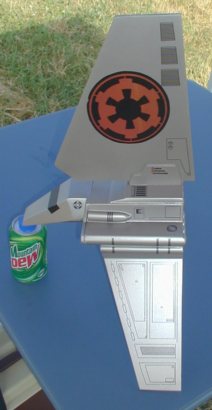Descon Imperial Lambda Shuttle (29mm)
Scratch - Imperial Lambda Shuttle (29mm) {Scratch}
Contributed by Nick Esselman
| Manufacturer: | Scratch |
![[Picture]](/images/archive/images_descon/lambda/nesselmanlambdashuttleslg.jpg) About a year ago, I got a "bug" to
create the Star Wars Imperial Lambda-Class Shuttle. I read information from
various Star Wars sites and started off on my project.
About a year ago, I got a "bug" to
create the Star Wars Imperial Lambda-Class Shuttle. I read information from
various Star Wars sites and started off on my project.
The project had many twists and variables, but in general I was confident that I could create a flying model of this Lambda Shuttle. It was going to fly on 29mm motors, too!
Along the way, I created a proto-type for 18mm motors and was very excited and pleased with the performance of it. Next I finished the 29mm version. You can see me holding both of those rockets at NYPower2002 (photo taken by Dean Oberg).
Since then I have created a 24mm version and utilized some new techniques to strengthen the fins...fins that must also be as light as possible.
You can see step-by-step details of my 29mm build by CLICKING HERE.
I will discuss some of the highlights of this project below.
First, I needed some blue-prints to follow and I was fortunate to find this site: Star Wars Technical Commentaries. Here I was able to get some prints and then scale them to the size of rocket I was building.

 Next, I felt I needed to try to
simulate this, so I made attempts with RockSim. (Click on the pictures to
download the RockSim files). I was pleased to see that, at least, in these
simulations, the rocket could fly. It took a massive nose cone override of 16
ounces, but one should have expected that.
Next, I felt I needed to try to
simulate this, so I made attempts with RockSim. (Click on the pictures to
download the RockSim files). I was pleased to see that, at least, in these
simulations, the rocket could fly. It took a massive nose cone override of 16
ounces, but one should have expected that.
Next came the various construction techniques, which you should review by following along in the step-by-step section.
 Other major obstacles that I had to overcome, was how to pack
parachutes into this bird. There was not a lot of room.
Other major obstacles that I had to overcome, was how to pack
parachutes into this bird. There was not a lot of room.
 Also how to
deploy them. I decided I wanted the 1 pound nose cone to get as far away as
possible from the body upon ejection, so it had its own parachute. Since the
parachutes are not packed in line with the motor ejection, how would I get the
main section's parachute to deploy. I used slip knots on the second eye-hook of
the nose cone so that it would jerk it out upon separation.
Also how to
deploy them. I decided I wanted the 1 pound nose cone to get as far away as
possible from the body upon ejection, so it had its own parachute. Since the
parachutes are not packed in line with the motor ejection, how would I get the
main section's parachute to deploy. I used slip knots on the second eye-hook of
the nose cone so that it would jerk it out upon separation.
I was also worried about a full ejection charge in the motor for a tube that is only 6" long. Therefore, on the EconoJet G38's that it flew on, I had carefully removed the ejection charge cover and removed nearly all of the ejection charge (above the small hole).

 The next
challenge, due to lack of forethought, was the rail buttons. I had always
planned on putting them on the bottom-center, however, when it came time to do
this they would not work there. Why? The tilt down of the nose cone!
The next
challenge, due to lack of forethought, was the rail buttons. I had always
planned on putting them on the bottom-center, however, when it came time to do
this they would not work there. Why? The tilt down of the nose cone!
I ended up putting two rail buttons off center, which I did not like, but had no choice. The other issue is with the short body the two rail buttons were fairly close to each other (3") and that is not the best configuration either.
The last component was that the motor had to be friction fit. I was sure upon ejection it would kick, but with the removal of most of the ejection charge and I issued the nose cone fit was looser than the friction fit, it was successful.
I have a short video of it's second flight, CLICK HERE
If I had to do it again, I would make my fins (wings) out of two 1/8" balsa pieces, plied together with 5-minute epoxy, and laminated with tracing paper. This is the new technique that I used on the 24mm version. I would have also modified the nose cone tilt to allow for the rail buttons. Watch, EMRR for an update on my 24mm version . . . because it really is the benefactor of all the learning on the 18mm proto-type and the 29mm project.



 |
 |